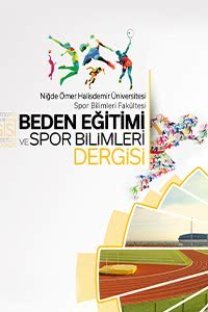Paramedik program öğrencilerinde beden eğitimi ve güç geliştirme dersinin vücut kompozisyonu ve fiziksel performans üzerine etkileri
Amaç:Kadın paramedik öğrencilerinde, ders programlarının içeriği olarak haftada 4 saat uygulanan, kuvvet ve aerobik dayanıklılık temellerine dayalı beden eğitimi derslerinin, vücut kompozisyonunda ve fiziksel performans üzerindeki etkileri değerlendirilmesidir. Gereç ve yöntem: Bu çalışma, yaş ortalaması 18±0.5 olan 23 kadın paramedik programı öğrencisinde uygulandı. 9 haftalık aerobik dayanıklılık ve kuvvet antrenmanının öncesinde ve sonrasında ağırlık, Beden Kitle İndeksi (BKI), vücut yağ oranı (VYO), esneklik testi, el-kavrama kuvvet testi, sırt kuvvet testi, wingate testi, dikey sıçrama testi, 20 metre mekik testi, şınav ve mekik değerleri saptandı. İstatistiksel analizi SPSS 15.0 paket programında yapıldı. Çalışma verilerinde Wilcoxon testi yapıldı. Bulgular: Paramedik grubu öğrencilerinde egzersiz öncesi ve egzersiz sonrası test verileri karşılaştırıldığında ağırlık, VYO, esneklik testi, el-kavrama kuvvet testi, sırt kuvvet testi, Wingate testi, şınav, mekik ve 20 metre mekik testi değerleri istatistiksel olarak anlamlı bulundu. Ancak BKI ve dikey sıçrama değerleri istatistiksel olarak anlamlı değişim tespit edilmedi. Tartışma: 9 haftalık kuvvet ve dayanıklılık antrenmanı sonucunda egzersiz öncesi ve egzersiz sonrası verileri karşılaştırıldığında, fiziksel ve fizyolojik parametrelerinde anlamlı değişim tespit edilmesi yapılan antrenmanın süre ve şiddet olarak bu parametreleri etkileyecek düzeyde olduğunu düşündürdü. Çalışmadan elde edilen bulgular literatürle uyumlu bulundu. Sonuç: 9 haftalık kuvvet ve dayanıklılık antrenmanının vücut kompozisyonu, fiziksel ve fizyolojik performans ölçümlerine olumlu etkileri olduğu görüldü.
The effects of physical education and strength development lessons on the body composition and physical performance of paramedic program students
Objective: The aim of this study is to determine the relationship between the effects of their fundamental strength and aerobic endurance of physical education, curriculum content, as applied to 4 hours per week, body composition and to evaluate its impact on physical performance of women paramedical students. Material and methods: The dates were collected from 23 women paramedical students (age:18±0.5 years). We assessed these subjects with weight, Body Mass Index (BMI), body fat percentage (BFP), flexibility test, handgrip, back strength test, Wingate test, vertical jump test, 20 meter shuttle run, shuttles and push-ups in this study. All tests were given twice: pre test and post test after the 9-weeks exercise program. SPSS 15.00 was used for statistical analyses. Wilcoxon signed-ranks test applied for differences between pre test and post test. Results: There was a significant difference between pre exercise and post exercise in weight, BFP, flexibility test, handgrip, back strength test, Wingate test, 20 meter shuttle run, shuttles and push-ups in this study. But this group was no different between pre exercise and post exercise in BMI and vertical jump test. Conclusion: Physical and physiological parameters were significantly. As the severity and duration of training would affect the levels of these parameters is suggested. From the study findings were consistent with the literature. The body composition, physical and physiological effects of the nine-week strength and endurance training were found to be positive for performance measurement.
___
- 1. Akgün N. Egzersiz Fizyolojisi. 4. baskı. Ege Üniversitesi Basımevi,s:49-52, İzmir, 1992.
- 2. American College of Sport Medicine, ACSM’s Guidelines for Exercise Testing and Prescription, 6th ed., Lippincott,Williams & Wilkins, s:6-21, Baltimore, MD, 2000.
- 3. Asna B, Aktaş N. Ankara Üniversitesi’nde Öğrenimlerini Sürdüren ve Lisanslı Olarak Spor Yapan Erkek Öğrencilerin Maksimal Aerobik Kapasitelerinin Belirlenmesi Üzerine Bir Araştırma. Spor Hekimliği Dergisi. 22(4): 177-85. 1987.
- 4. Çalış M, Ergen E, Turnagöl H, Arslan O. Beden Eğitimi Derslerinin Bir Öğretim Yılı Boyunca 15-16 Yaş Grubu Öğrenciler Üzerindeki Fizyolojik Etkilerinin EUROFIT Test Bataryası İle İzlenmesi. Spor Bilimleri 2. Ulusal Kongresi Bildirileri. s: 367-369. Hacettepe, Ankara 1992.
- 5. Çetin C, Keçeci AD, Erdoğan A ve ark. Influence of custom Made Mouth Guards on Strength, Speed and Anaerobic Performance of Taekwondo Athletes. Dental Traumatology. 25: 272-276, 2009.
- 6. Çokivecan F. Beden Eğitimi ve Spor Yüksekokulunda 4 Yıllık Beden Eğitimi ve Spor Antrenmanlarının Kız Öğrencilere Kazandırdığı Fizyolojik Özellikler. Yüksek Lisans Tezi. İzmir. 1981.
- 7. Gamble RP, Stevens AB, McBrien H, Black A, Cran GW, Boreham CA. Physical fitness and occupational demands of the Belfast ambulance service. Br J Ind Med. Sep;48(9):592-6, 1991
- 8. Kandeydi H. Beden Eğitimi ve Spor Yüksekokulundaki Beden Eğitimi ve Spor Antrenmanlarının Erkek Öğrencilere Kazandırdığı Fizyolojik Özellikler. Yüksek Lisans Tezi. İzmir. 1982.
- 9. Leyk D, Rohde U, Erley O ve ark. Ergonomics, May. 50(5), 752-762, 2007
- 10. Ramalho AC, Lima ML, Cambui FNZ, Barbosa C, Andrade A, Viana A et al. The effect of resistance versus aerobic training on metabolic control in patients with type-1 diabetes mellitus. Diabetes Research and Clinical Practice 72; 271–276, 2006
- 11. Tamer K, Sporda Fiziksel-Fizyolojik Performansın Ölçülmesi ve Değerlendirilmesi. 2. Baskı. Bağırgan Yayınevi, Ankara, 115-144, 2000
- 12. Türkmen S, Kayatekin M, Varol R, Özgönül H, Beden Eğitimi Derslerinin Bir Öğretim Yılı Boyunca Ambulans ve Acil Bakım Teknikerliği Öğrencileri Üzerindeki Fiziksel ve Fizyolojik Etkileri, Performans.1 (3):141-145,1995
- 13. Yenal S, Hastane Öncesi Acil Bakım Eğitimi Sürecinde Mesleksel Risk Etmenleri İle İlgili Bilgi Düzeyinin Değerlendirilmesi, DEÜ Halk Sağlığı Yüksek Lisans Tezi, İzmir-2009
- ISSN: 1307-6477
- Yayın Aralığı: Yılda 3 Sayı
- Başlangıç: 2007
- Yayıncı: Niğde Üniversitesi Beden Eğitimi ve Spor Yüksek Okulu
Sayıdaki Diğer Makaleler
Badmintoncularda reaksiyon zamanı ve denge ilişkisi
ERKAL ARSLANOĞLU, MERT AYDOĞMUŞ, CANSEL ARSLANOĞLU, ÖMER ŞENEL
TUĞÇE ORKUN ERKILIÇ, Gülgün ERSOY
Antrenmanın sıçrama performansı üzerine etkisinin farklı yaş grubu çocuklarda incelenmesi
Hayriye ATABEK ÇAKIR, Rıdvan ÇOLAK, Caner AÇIKADA
Suphi TÜRKMEN, AKSEL ÇELİK, Mert TUNAR, MEHMET İSMET TOK, PINAR TATLIBAL, Elif Nilay ADA DAŞTAN
